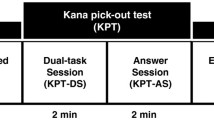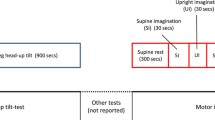Abstract
Subtle signs of autonomic dysfunction and orthostatic intolerance have been reported in patients with chronic fatigue syndrome (CFS). To assess cardiovascular autonomic function noninvasively in an unselected group of patients with CFS, we examined responsiveness to several cardiovascular reflex tests in 37 CFS patients and 38 healthy control subjects. Blood pressure and heart rate (HR) were recorded continuously by a Finapres device before and during forced breathing, standing up, Valsalva maneuver, and sustained handgrip exercise (HG). In addition, a mental arithmetic test was carried out and questionnaires to assess the severity of CFS symptoms were completed. At rest, there were no significant differences in blood pressure or in HR between the two groups. The in- and expiratory difference in HR tended to be lower in CFS patients (28.4±10.5 beats) than in healthy controls (32.2±9.5) (p=0.11). The maximal increase in HR during standing up was not significantly different between the CFS group (37.6±8.9 beats) and the control group (40.2±8.9 beats). There were no significant differences between both groups with regard to the Valsalva ratio, but the systolic and diastolic blood pressure responses were significantly larger in CFS patients, despite the fact that many CFS patients were not able to sustain the Valsalva maneuver. The HR response to MA was significantly less in the CFS group (22.6±9.9) than in the control group (29.5±16.7) (p<0.05), suggesting impaired cardiac sympathetic responsiveness to mental stress. The lower HR responses could not be explained by the level of concentration in the CFS group. During HG exercise, the hemodynamic responses were lower in the CFS group than in the control group, but this might be attributed to the lower level of muscle exertion in CFS patients. There were no significant differences between CFS patients with and without symptoms of autonomic dysfunction regarding the hemodynamic responses to the cardiovascular reflex tests. The findings of the study suggest that there are no gross alterations in cardiovascular autonomic function in patients with CFS.
Similar content being viewed by others
References
Fukuda K, Straus SE, Hickie I, Sharpe MC, Dobbins JG, Komaroff A. The chronic fatigue syndrome: a comprehensive approach to its definition and study. International Chronic Fatigue Syndrome Study Group.Ann Intern Med 1994; 121:953–959.
Vercoulen JH, Swanink CM Fennis JF, Galama JM, Van-der-Meer JW, Bleijenberg G. Dimensional assessment of chronic fatigue syndrome.J Psychosom Res 1994; 38:383–392.
Shafran SD. The chronic fatigue syndrome.Am J Med 1991; 90:730–739.
Klonoff DC. Chronic fatigue syndrome.Clin Infect Dis 1992; 15:812–823.
Low PA, Opfer Gehrking TL, McPhee BR, Fealey RD, Benarroch EE, Willner CL, et al. Prospective evaluation of clinical characteristics of orthostatic hypotension.Mayo Clin Proc 1995; 70:617–622.
Rowe PC, Bou-Holaigah I, Kan JS, Calkins H. Is neurally mediated hypotension an unrecognised cause of chronic fatigue?Lancet 1995; 345:623–624.
Bou-Holaigah I, Rowe PC, Kan J, Calkins H. The relationship between neurally mediated hypotension and the chronic fatigue syndrome.JAMA 1995; 274:961–967.
De Lorenzo F, Hargreaves J, Kakkar VV. Possible relationship between chronic fatigue and postural tachycardia syndromes.Clin Auton Res 1996; 6:263–264.
Freeman R, Komaroff AL. Does the chronic fatigue syndrome involve the autonomic nervous system?Am J Med 1997; 102:357–364.
Stewart J, Weldon A, Arlievsky N, Li K, Munoz J. Neurally mediated hypotension and autonomic dysfunction measured by heart rate variability during head-up tilt testing in children with chronic fatigue syndrome.Clin Auton Res 1998; 8:221–230.
Schondorf R, Benoit J, Wein T, Phaneuf D. Orthostatic intolerance in the chronic fatigue syndrome.J Aut Nerv Syst 1999; 75: 192–201.
Yataco A, Talo H, Rowe P, Kass DA, Berger RD, Calkins H. Comparison of heart rate variability in patients with chronic fatigue syndrome and controls.Clin Auton Res 1997; 7:293–297.
Consensus statement. Report and recommendations of the San Antonio conference on diabetic neuropathy. American Diabetes Association American Academy of Neurology.Diabetes Care 1988; 11:592–597.
Ewing DJ, Clarke BF. Diagnosis and management of diabetic autonomic neuropathy.Br Med J Clin Res Ed 1982; 285:916–918.
Sharpe MC, Archard LC, Banatvala JE, Borysiewicz LK, Clare AW, David A, et al. A report—chronic fatigue syndrome: guidelines for research.J R Soc Med 1991; 84:118–121.
Bergner M, Bobbitt RA, Carter WB, Gilson BS. The Sickness Impact Profile: development and final revision of a health status measure.Med Care 1981; 19:787–805.
Jacobs HM, Luttik A, Touw-Otten FW, de-Melker RA. De sickness impact profile: resultaten van een valideringsonderzoek van de Nederlandse versie.Ned Tijdschr Geneeskd 1990; 134:1950–1954.
Arrindell WA, Ettema JHM.SCL-90: Handleiding bij een multidimensionele psychopathologie-indicator. Lisse: Swets & Zeitlinger; 1986.
Netten PM, Boots JM, Bredie SJ, den Arend JA, Mol MJ, Thien T, et al. An automated computerized method using Finapres for measuring cardiovascular reflexes.Clin Sci Colch 1992; 83:157–163.
Cobelens FG, Leentvaar-Kuijpers A. Compliance with malaria chemoprophylaxis and preventative measures against mosquito bites among Dutch travellers.Trop Med Int Health 1997; 2:705–713.
Montague TJ, Marrie TJ, Klassen GA, Bewick DJ, Horacek BM. Cardiac function at rest and with exercise in the chronic fatigue syndrome.Chest 1989; 95:779–784.
Riley MS, O'Brien CJ, McCluskey DR, Bell NP, Nicholls DP. Aerobic work capacity in patients with chronic fatigue syndrome.BMJ 1990; 301:953–956.
Sisto SA, Tapp W, Drastal S, Bergen M, DeMasi I, Cordero D, et al. Vagal tone is reduced during paced breathing in patients with the chronic fatigue syndrome.Clin Auton Res 1995; 5:139–143.
Pagani M, Lucini D, Mela GS, Langewitz W, Malliani A. Sympathetic overactivity in subjects complaining of unexplained fatigue.Clin Sci Colch 1994; 87:655–661.
Cordero DL, Sisto SA, Tapp WN, LaManca JJ, Pareja JG, Natelson BH. Decreased vagal power during treadmill walking in patients with chronic fatigue syndrome.Clin Auton Res 1996; 6:329–333.
Duprez DA, De Buyzere ML, Drieghe B, Vanhaverbeke F, Taes Y, Michielsen W, et al. Long- and short-term blood pressure and RR-interval variability and psychosomatic distress in chronic fatigue syndrome.Clin Sci Colch 1998; 94:57–63.
Kapoor WN, Brant N. Evaluation of syncope by upright tilt testing with isoproterenol. A nonspecific test.Ann Intern Med 1992; 116:358–363.
Stokes MJ, Cooper RG, Edwards RH. Normal muscle strength and fatigability in patients with effort syndromes.BMJ 1988; 297:1014–1017.
Gibson H, Carroll N, Clague JE, Edwards RH. Exercise performance and fatiguability in patients with chronic fatigue syndrome.J Neurol Neurosurg Psychiatry 1993; 56:993–998.
Eckberg DL, Fritsch JM. Human autonomic responses to actual and simulated weightlessness.J Clin Pharmacol 1991; 31:951–955.
Convertino VA, Doerr DF, Eckberg DL, Fritsch JM, Vernikos Danellis J. Head-down bed rest impairs vagal baroreflex responses and provokes orthostatic hypotension.J Appl Physiol 1990; 68:1458–1464.
Gaffney FA, Nixon JV, Karlsson ES, Campbell W, Dowdey AB, Blomqvist CG. Cardiovascular deconditioning produced by 20 hours of bedrest with head-down tilt (-5 degrees) in middle-aged healthy men.Am J Cardiol 1985; 56:634–638.
Bazelmans E, Bleijenberg G, van der Meer JWM, Folgering H. Physical deconditioning a perpetuating factor in chronic fatigue syndrome? A controlled study on maximal exercise performance and relations with fatigue, impairment, and level of activity. 1999, in press.
Author information
Authors and Affiliations
Rights and permissions
About this article
Cite this article
Soetekouw, P.M.M.B., Lenders, J.W.M., Bleijenberg, G. et al. Autonomic function in patients with chronic fatigue syndrome. Clinical Autonomic Research 9, 334–340 (1999). https://doi.org/10.1007/BF02318380
Received:
Accepted:
Issue Date:
DOI: https://doi.org/10.1007/BF02318380




